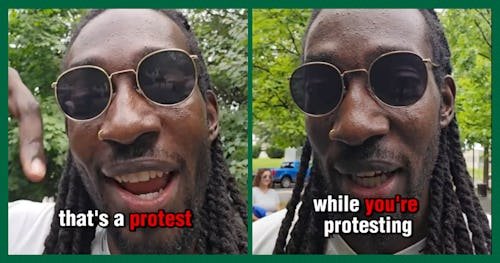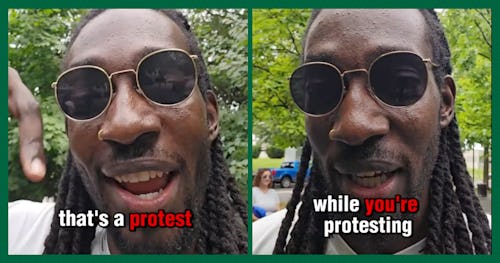

Every Saturday, there’s at least several dozen protesters with signs gathered on my town’s central thoroughfare. It’s smack-dab in the middle of our town, just about everyone has had a chance to read their signs and hear their chants. My kids are older, and pretty politically aware, but not all kids are at the age to pay attention to NPR or head over to a news website and really absorb what the journalists are saying. So how do you explain protests to young children? TikTok creator and parenting coach Gabriel (aka @the_indomitable_blackman) recently offered some helpful tips to get you started.
Start with what they know
It can be easy to launch into a story or explanation, but you might be getting off on the wrong foot. Instead, ask what has your child heard? What have they heard? What do they already understand about what’s happening? It might be more than you think, or they might be way off base and you’re going to have to start in a different spot than you realized.
As Gabriel puts it “Don’t start with your agenda: start with their questions.”
Explain what a protest is
You don’t have to get into the history of protest movements. A simple definition will do. Gabriel offers, “A protest is when people come together to speak up about something that isn’t fair.” It also helps to name emotions. A kid might not understand the nuances of the issue at hand, but they can understand if people feel scared, sad, angry, or worried.
Encourage them to share how they feel
Again, this is going to help you guide your approach. Because maybe you didn’t know they felt scared and, suddenly, the conversation is going to be more about reassurance than explanation. Of course, let them know you are there to keep them safe.
Mention injustices gently, but don’t lie or sugarcoat
This can be a delicate balance, but it is possible. For example, you can talk about racism as “people being treated badly because of who they are” without going into the horrifying details of lynching. Gabriel suggests turning to kid-friendly content online or in books to help you with this. (There are good resources!)
And finally, remember: “This isn’t a lecture: it’s a conversation.”
As with any important life lesson, these aren’t one-and-done lessons. Keep lines of communication open and, before you know it, your kids might be teaching you a thing or two.


